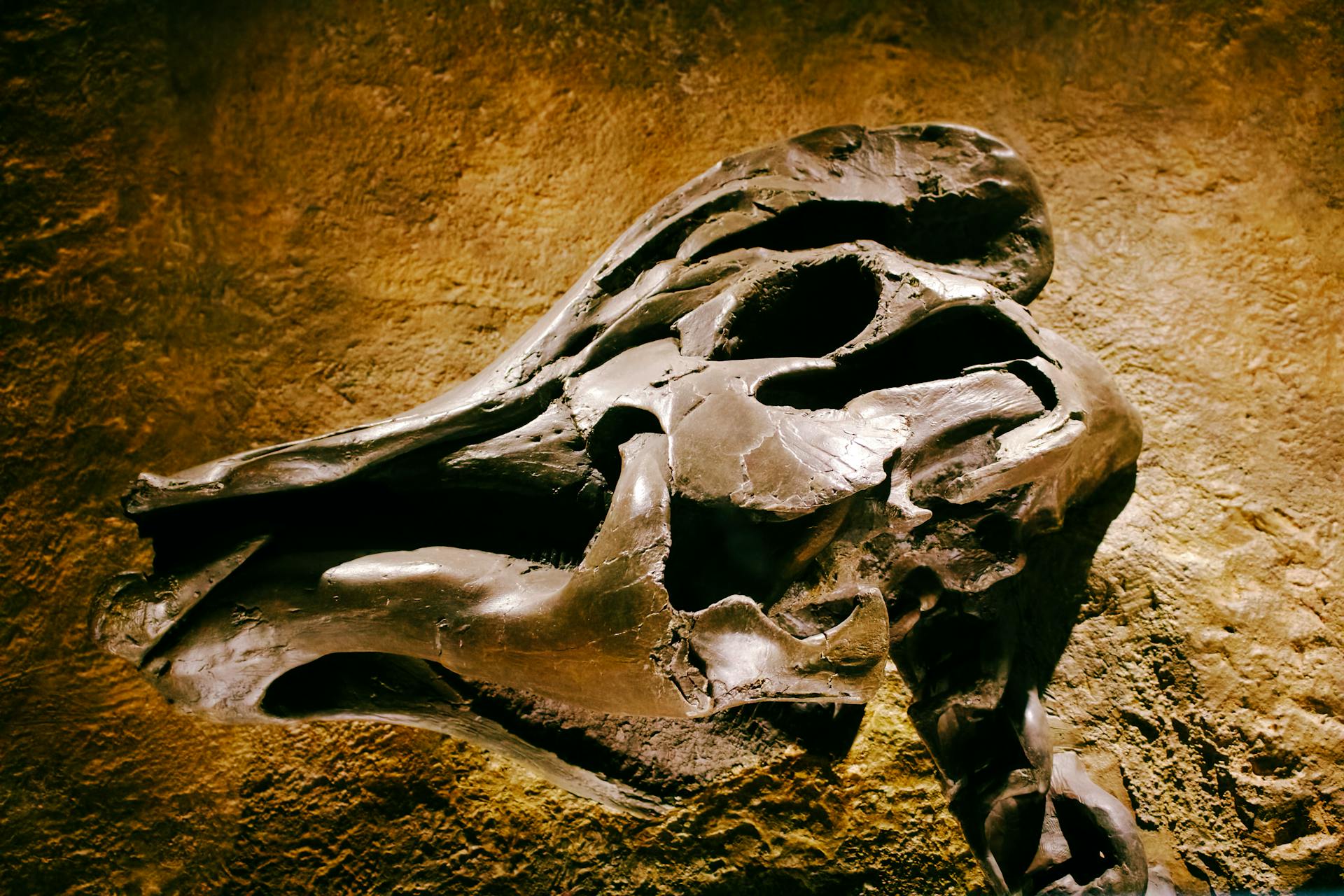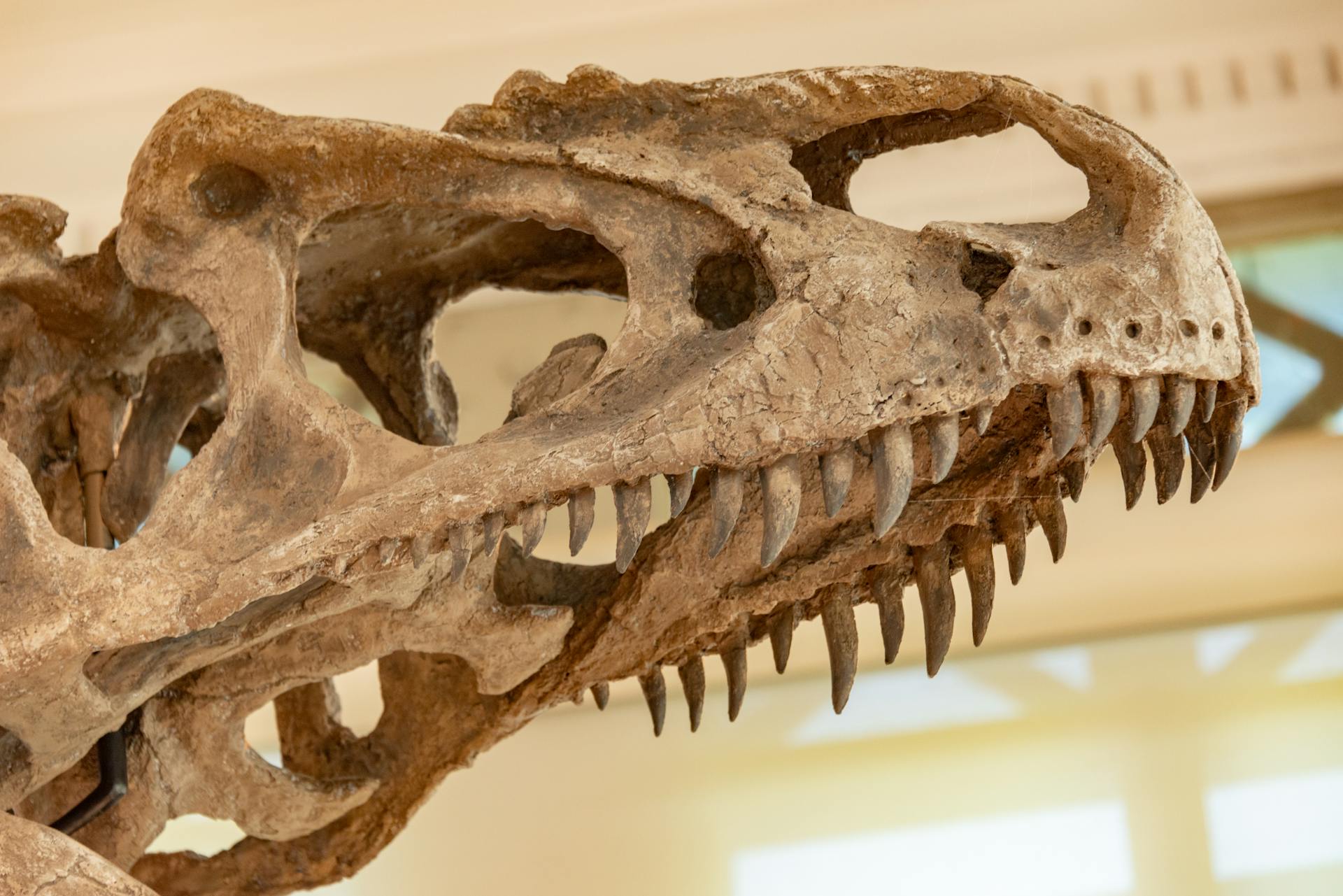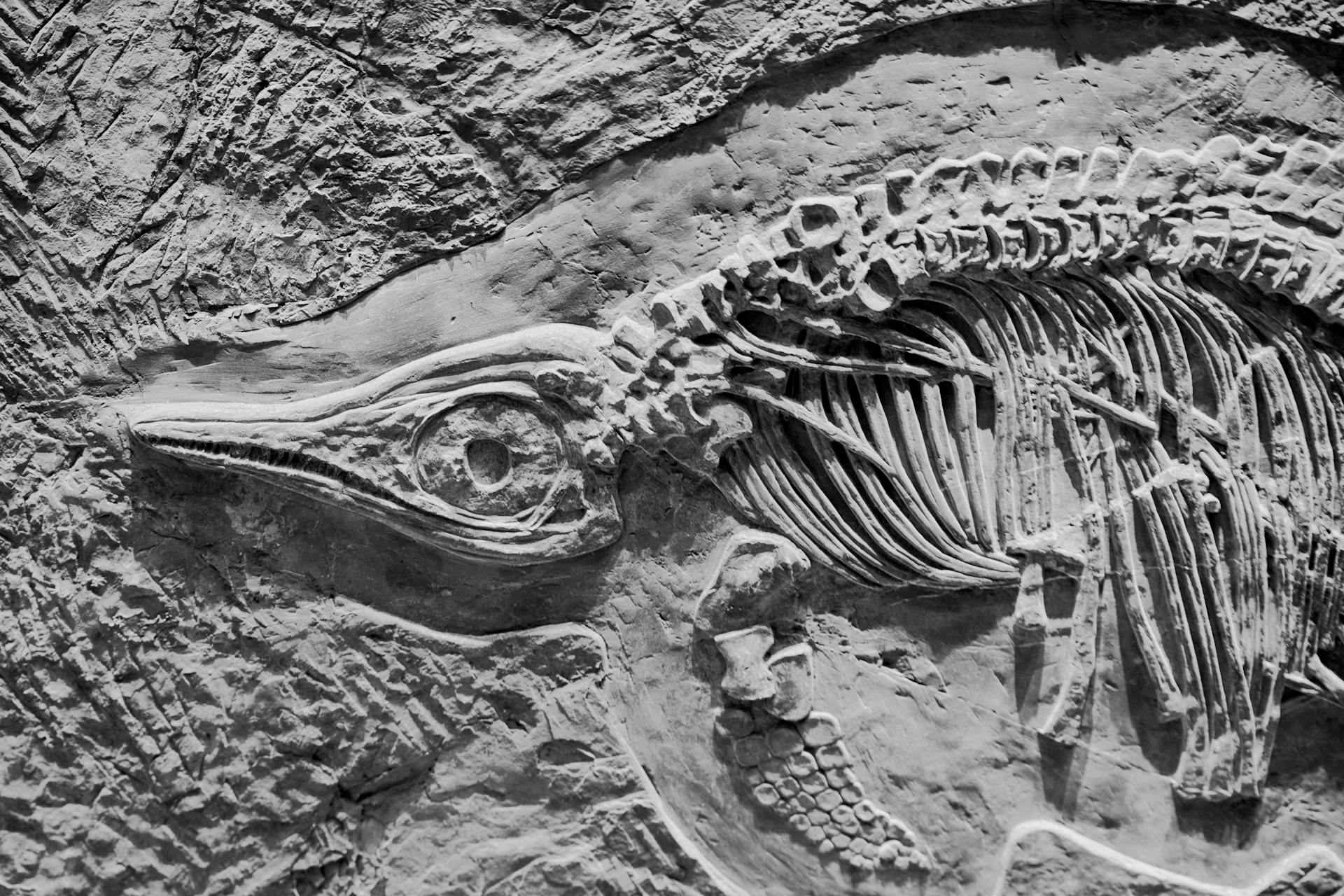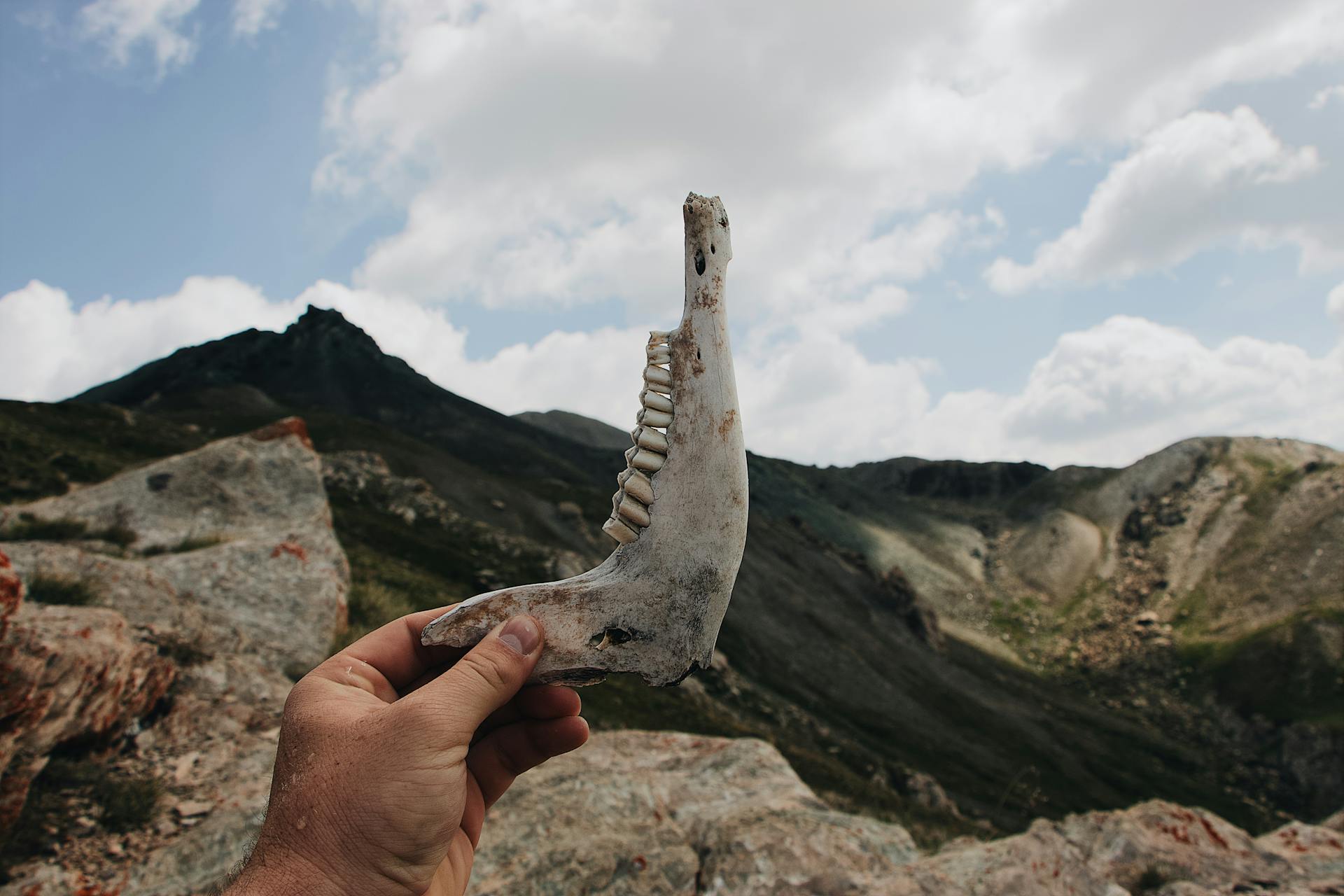
Dogs have a rich history that spans thousands of years, and it's fascinating to explore their evolutionary journey through time. The earliest known ancestors of modern dogs date back to the Late Miocene era, around 22 million years ago.
These early canine-like species, such as Hesperocyon and Epicyon, were small and weasel-like, with sharp teeth and claws. They likely preyed on small animals and plants.
Their fossil records show that these early canines were highly adaptable and able to thrive in a variety of environments.
Expand your knowledge: Dog Biscuits for Small Dogs
Fossil Record
The fossil record of dogs is a treasure trove of information about their evolution and history. The family Canidae originated in North America and spent most of its 40-million-year history on that continent.
Fossilized deposits have been found in the Great Plains, extending east from the Rocky Mountains across Texas, Colorado, Nebraska, Wyoming, and South Dakota. This region has yielded some of the best fossil finds, including those of Prohesperocyon wilsoni, the first identifiable member of the dog family.
The early canids showed an increase in body mass over time, with some species developing specialized hypercarnivorous diets that made them prone to extinction.
Eocene Epoch
The Eocene epoch was a pivotal time in the evolution of the dog family, Canidae. Around 50 million years ago, the Carnivora split into two main divisions: caniform (dog-like) and feliform (cat-like).
Carnivorans evolved after the extinction of the non-avian dinosaurs 66 million years ago. The first identifiable member of the dog family, Prohesperocyon wilsoni, arose around 40 Mya in southwest Texas.
Prohesperocyon had slightly longer limbs than its predecessors and parallel and closely touching toes, which differ markedly from the splayed arrangements of the digits in bears. Its fossils have been found in southwest Texas.
Canidae soon divided into three subfamilies: Hesperocyoninae (about 39.74–15 Mya), Borophaginae (about 34–32 Mya), and Caninae (about 34–30 Mya; the only surviving subfamily).
Oligocene Epoch
The Oligocene epoch was a pivotal time in the evolution of canids. By this point, all three subfamilies of canids (Hesperocyoninae, Borophaginae, and Caninae) had appeared in the fossil record of North America.
One of the earliest and most primitive branches of the Canidae was Hesperocyoninae. This subfamily included the coyote-sized Mesocyon, which roamed the grasslands of North America during the Oligocene (38–24 Mya).
These early canids likely evolved to pursue prey quickly in their grassland habitat and resembled modern viverrids in appearance. They eventually became extinct in the middle Miocene.
The genus Hesperocyon gave rise to Archaeocyon and Leptocyon, which led to the borophagine and canine radiations. This marked a significant turning point in the evolution of canids.
Around 8 Mya, the Beringian land bridge allowed members of the genus Eucyon to enter Asia from North America and eventually colonize Europe.
Taxonomy and Relationships
The family Canidae has a rich evolutionary history that spans 40 million years. They originated in North America during the Late Eocene, around 37.8-33.9 million years ago.
The Canidae first appeared in North America and spent most of their history on that continent, with the best fossilized deposits found in the Great Plains, extending east from the Rocky Mountains across Texas, Colorado, Nebraska, Wyoming, and South Dakota.
The family Canidae is represented by the two extinct subfamilies Hesperocyoninae and Borophaginae, and the extant subfamily Caninae, which includes all living canids and their most recent fossil relatives.
All living canids as a group form a dental monophyletic relationship with the extinct borophagines, with both groups having a bicuspid (two points) on the lower carnassialtalonid, which gives this tooth an additional ability in mastication.
The cat-like Feliformia and dog-like Caniformia emerged within the Carnivoramorpha around 45-42 million years ago.
Here's a breakdown of the phylogenetic relationships of canids within Caniformia, based on fossil finds:
Characteristics and Behavior
Most canids are social animals and live together in groups, with some species forming packs or living in small family groups depending on the circumstances.
In general, they are territorial or have a home range and sleep in the open, using their dens only for breeding and sometimes in bad weather.
A male and female pair work together to hunt and raise their young in most foxes and many of the true dogs, while larger canids like gray wolves live in larger groups called packs.
Related reading: Groups of Dogs in Dog Shows
Some species, like African wild dogs, have packs that may consist of 20 to 40 animals, and packs of fewer than about seven individuals may be incapable of successful reproduction.
Within a canid pack, there is a system of dominance so that the strongest, most experienced animals lead the pack, with the dominant male and female being the only pack members to breed in most cases.
A different take: Animals Related to Dogs
Characteristics
You know, people with certain characteristics can be quite fascinating to be around. They often have a strong sense of self-awareness, which helps them navigate complex social situations with ease.
Their ability to read people and situations is uncanny, and they can usually tell when someone is being insincere. This trait often makes them popular among friends and acquaintances.
They're also known for being highly adaptable, which allows them to thrive in a wide range of environments. Whether it's a new job, a move to a new city, or a change in relationships, they can roll with the punches.

Their intuition is often spot on, and they can pick up on subtle cues that others might miss. This can be a real asset in both personal and professional settings.
They're not afraid to take calculated risks, which can sometimes lead to unexpected rewards. However, they're also not reckless, and they know when to play it safe.
Their ability to multitask is impressive, and they can juggle multiple projects and responsibilities with ease. This skill is particularly useful in fast-paced work environments.
Their strong sense of empathy allows them to connect with people from all walks of life, making them natural mediators and peacemakers.
Dentition
Canids have a unique dental arrangement, which is crucial for their survival. Their teeth are numbered from the front of the mouth to the back, and they use a specific notation system to identify the different types of teeth.
The upper-jaw teeth in canids are denoted by upper-case letters, while the lower-jaw teeth are denoted by lower-case letters. This system helps us understand the anatomy of their teeth.
For another approach, see: Dog Food for Dogs with No Teeth

The carnassials, which are used to shear the muscle and tendon of prey, are formed by the upper premolar P4 and the lower molar m1. These teeth work together in a scissor-like action to cut through meat.
A canid's dietary habits can be determined by the ratio between the trigonid and the talonid on the lower carnassial. A larger trigonid indicates a hypercarnivore, while a larger talonid indicates a more omnivorous diet.
The length of the lower carnassial is a good estimate of a carnivore's body size. This is because the length of this tooth is relatively low in variability.
Most canids have 42 teeth, with a dental formula of 3.1.4.23.1.4.3. This means that they have three incisors, one canine, four premolars, and three molars on the upper jaw, and the same arrangement on the lower jaw.
Check this out: Three Dog Night Name Origin
Social Behavior
Social behavior is a key aspect of canid nature. Almost all canids are social animals and live together in groups.

Some species, like gray wolves and African wild dogs, live in larger groups called packs. These packs can consist of up to 40 animals, and smaller packs may struggle to reproduce.
In most cases, a dominant male and female lead the pack, with the strongest and most experienced animals taking charge.
Hunting in packs has a significant advantage, allowing canids to tackle larger prey items. This is especially true for species like African wild dogs, where packs are essential for successful hunting.
Individuals within a pack often have a system of dominance, with the strongest animals leading the way.
Check this out: Wild Dog vs Domestic Dog
Description and History
The family Canidae, which includes dogs, originated in North America 40 million years ago. This is well established by fossil records.
Xiaoming Wang and Richard H. Tedford have spent 20 years studying the evolutionary history of the family Canidae. They've established the modern framework for the evolutionary relationship of canids.
The best fossilized deposits of canids have been found in the Great Plains, extending east from the Rocky Mountains across Texas, Colorado, Nebraska, Wyoming, and South Dakota. This region has provided a wealth of information about the early history of dogs.
The family Canidae has a rich fossil record, with 214 species identified through fossil records. Of these, 37 are still with us today, while the others have been reconstructed through fossil finds.
A key geological event that allowed canids to scatter to new continents was the Beringian land bridge, which connected present-day Alaska and Eastern Siberia during the Pleistocene Ice Age.
Sources
- https://seattledogshow.org/2010/05/dogstheir-fossil-relatives-evolutionary-history/
- https://www.nhbs.com/en/dogs-their-fossil-relatives-and-evolutionary-history-book
- https://www.fieldmuseum.org/blog/fossil-beardogs-shed-light-evolution-dogs
- https://en.wikipedia.org/wiki/Canidae
- https://www.interabangbooks.com/book/9780231135290
Featured Images: pexels.com


